|
What is it, exactly, that defines a George Romero film? For many, it will be the presence of the undead and a small band of humans fighting for survival. While it's unfair to compartmentalise any filmmaker based on a small number of their works, there's a good reason why this one will forever be associated primarily with his zombie movies. It was he, after all, who not only gave birth to the modern zombie movie with Night of the Living Dead, but with its sequels, Dawn of the Dead and Day of the Dead, he effectively drew up a template from which almost all subsequent zombie movies have been stamped. It doesn't help that all three of these films are masterpieces of type, and while his later forays into this subgenre may not have been as innovative or influential, they still tend to outshine the plethora of cheapjack carbon-copy knock-offs that so many witless would-be filmmakers looking to break into horror seem to think is cinematic a rite of passage. And in a genre that thrives on socio-political subtext, Romero is a master at infusing his horror tales with deeper meaning and layering them to such a degree that they command repeat viewings to fully unpack their content.
But there is more to Romero's CV than his Living Dead sextet. Just last year, Arrow released a box set containing three of the four films he made between Night of the Living Dead and Dawn of the Dead, only one of which bears a stylistic and structural similarity to his zombie movies. After these, he directed the brilliant revisionist vampire tale Martin, and immediately following Dawn he abandoned horror completely and made Knightriders, a captivating film about a motorcycle riding medieval re-enactment troupe. While he returned to horror for his next film, Creepshow, a delightful five-story collaboration with Stephen King, it's stylistically light years from the Living Dead films, and more fun than any other film in this director's oeuvre.
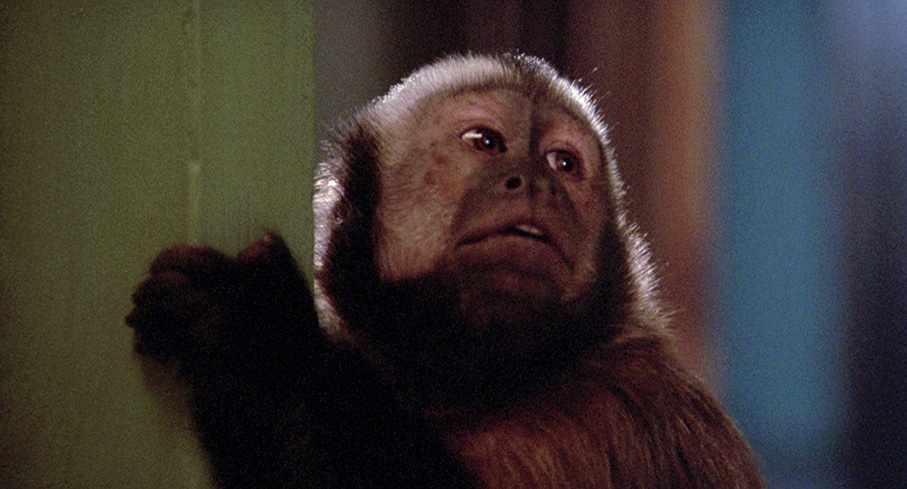
Romero continued making films as the 20th century stumbled to a close and the new one began, but his later output is rarely discussed in the same breath as his celebrated earlier work. There are reasons for this, of course. Night and Dawn were both genuinely ground-breaking films, Martin is unlike any other vampire movie (save for the 2016 The Transfiguration, which borrows heavily from it), and Creepshow set an impossibly high benchmark for all future portmanteau horror movies. Yet while Romero's post-Day of the Dead work might not reach the heights of his trailblazing years, there are still some too-often undervalued treats in there, my favourite of which is the 1988 horror-thriller, Monkey Shines.
The story gets under way with little in the way of preamble when the athletic Allan Mann is hit by a car whilst out jogging and is left paralysed from the neck down. Reliant on a wheelchair that he controls with his mouth, he has considerable trouble adjusting to his new life, which is not helped by the news that his girlfriend Linda has been having an affair with John Wiseman, the surgeon who operated on him after the accident. When Allan tries to take his own life, his friend and former roommate Geoffrey contacts Melanie Parker, a specialist in training helper monkeys for quadriplegics, to see if Allan can be made part of her programme. The animals she is currently training have already been assigned, but when Geoffrey, a university research scientist, offers to donate one of the monkeys from his lab – one that he assures her is in perfect health and has already undergone some conditional training – she agrees to take it on. What Geoffrey neglects to mention is that he has been experimenting on the animal by injecting it with human brain tissue, which has make it somewhat smarter than the average Capuchin monkey.
Even before this animal – which Melanie names Ella – is partnered with Allan, there are a couple of things we as an audience can be comfortably sure of. The first is that the serum that Geoffrey has been injecting into Ella will eventually prompt her to develop human characteristics and create problems for Allan, and the second is that he and pretty young Melanie will take a shine to each other and a romantic relationship between them will eventually develop. But it's the manner in which these story strands cross over that intrigues, as Ella bonds with Allan to such a degree that she becomes jealous of the affection he is developing for Melanie, and when Allan comes into conflict with his testy nurse Maryanne or his overbearing mother Dorothy, Ella is not about to sit by and watch him suffer.
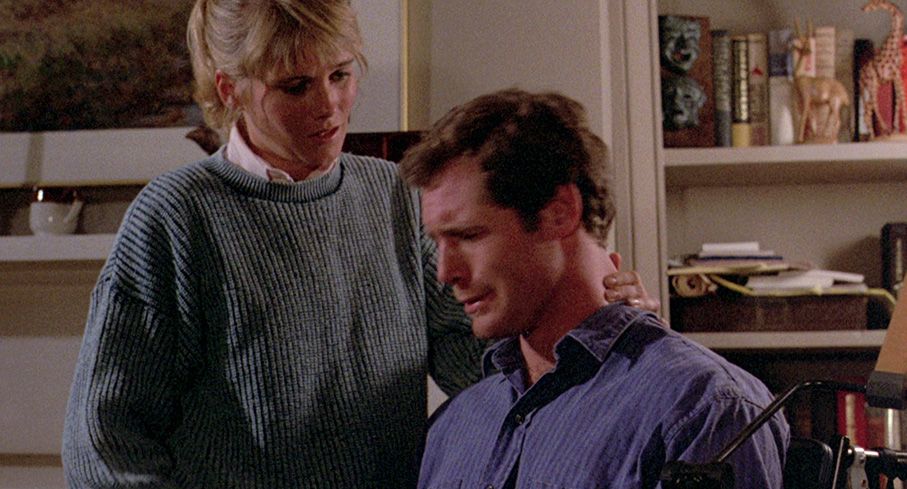
As a premise, this all has the ring of an exploitation cheapie destined to provoke more unintentional laughs than scares, but in Romero's hands it always feels oddly plausible. A solid script helps, one convincingly sold by a cast that treats the material as seriously as it would a straight-up relationship drama. As Allan and Melanie, Jason Beghe and Kate McNeil may not quite have that indefinable something that marks them for future superstardom, but both acquit themselves admirably here. This is particularly true of Beghe, who not only has to portray a range of sometimes extreme emotions without recourse to body language, but is intermittently required to test the limits of audience sympathy by venomously wishing the sort of harm on others that the devoted Ella is all too willing to inflict. Impressive though the leads are, however, the real interest here lies in a supporting cast that include a couple future faces of note in Stephen Root as Geoffrey's boss and nemesis Dean Burbage and Stanley Tucci as the adulterous Dr. Wiseman, plus enjoyable turns from film and TV veteran Joyce Van Patten as Dorothy and Romero's then wife Christine Forrest as the bitchily intolerant nurse Maryanne Hodges. But the star of the show has to be John Pankow, who plays Geoffrey with such fiery drive and commitment that he is able to sell even the more outlandish aspects of story as real.
What the film's success of failure really hangs on, of course, is whether we swallow the idea that a monkey the size of a domestic cat could pose a tangible threat to fully-grown humans. Here Romero and his collaborators strike gold by opting not to rely on effects or puppetry, but instead use an actual Helping Hands monkey, one trained to carry out the very tasks portrayed in the film. Some fakery was still required, and this is supplied by a makeup effects team led Tom Savini and Greg Nicotero, but their work is so deftly cut into the action by Romero's ace regular editor Pasquale Buba that you'll need to pause and rewind a few times to spot it.
By showing us up front that Ella is genuinely capable of carrying out a range of human tasks, the idea that she would also have the capacity to inflict physical harm on others also becomes disarmingly easy to swallow. That said, the film does push its luck a little by suggesting not only that there is a telepathic link between Allan and Ellen, but that it is starting to have a physiological effect on Allan. This does, however, allow Romero to expand on the Jekyll and Hyde undertones of Michael Stewart's source novel, and chance-aligns the film with David Cronenberg's The Brood, with Ellen serving a similar function to Samantha Eggar's children of rage in the earlier film.
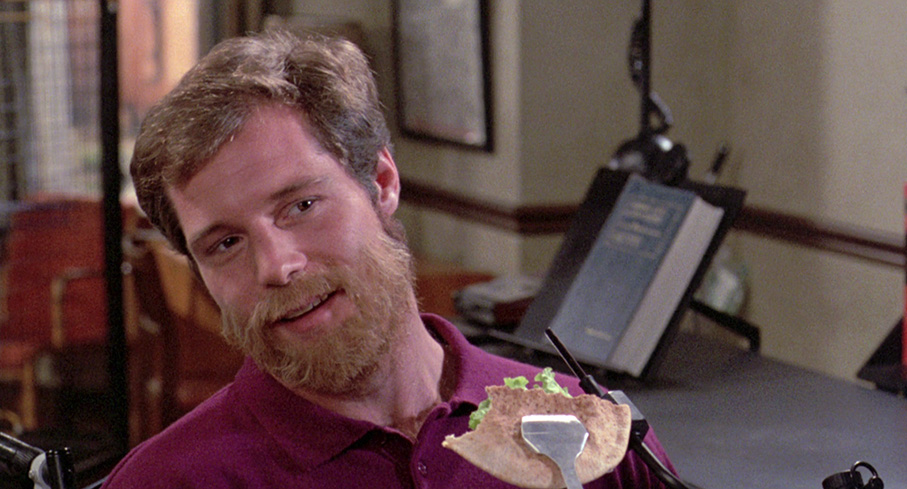
For me, at least, however, there are a couple of small things that keep me from ranking the film as one Romero's very best. As Romero's first film produced for a studio (in this case Orion), it had a bigger budget than any of his previous movies but also has – perhaps inevitably – a more studio-produced look and feel, one that intermittently had me itching for the edginess of Romero's earlier independent work. This partnership also saw the film fall victim to studio interference when the execs insisted that Romero reshoot the ending after negative comments about the original at the preview screening. But as Romero himself reveals elsewhere this very disc, the change insisted by the studio did not address the specifics of the preview audience complaints, which added a final jump-scare that the film didn't need (Carrie has a lot to answer for here) and left the very thing that the audience was bugged by unaddressed. And while I'd normally not be on the side of a preview audience, in this case I'm with them all the way, but can't discuss why in detail without delivering a massive spoiler for first-timers. And this may be a little picky on my part, but with make-up artists of the calibre of Savini and Nicotero on board, I'm dumfounded by Allan's post-operation and recuperation facial hair, which to me always looked like the pasted-on fake beard that it is.
Ultimately, though, these are minor objections for a movie that otherwise does so much so damned well. Despite a close to two-hour running time, its energy, brisk pace and consistently busy plot makes it feel a lot shorter. It also builds to a final twenty minutes that's as nail-bitingly tense as in Romero's distinguished career, despite that all-too-common climactic genre crutch of having the whole thing play out against a handily timed thunderstorm. It may not have broken new ground or turned a genre on its head, but Monkey Shines is still a smart, very well-acted and – crucially – taut and involving thriller that showcases Romero's very real skill as a cinematic storyteller, and further cements his position as a Horror God.
A solid 1.85:1 1080p transfer that is a couple of notches short of pristine, with a very slight softness and even glumness to some shots, but the image is usually crisp enough when the light levels are good. Contrast is generally well balanced and the colour nicely rendered, with the brighter primes often vivid when they appear (Geoffrey's lab bathed in red light is a good example). Film grain is clearly visible but this does not seem to be the result of digital enhancement, and the image is clean of dust and damage.
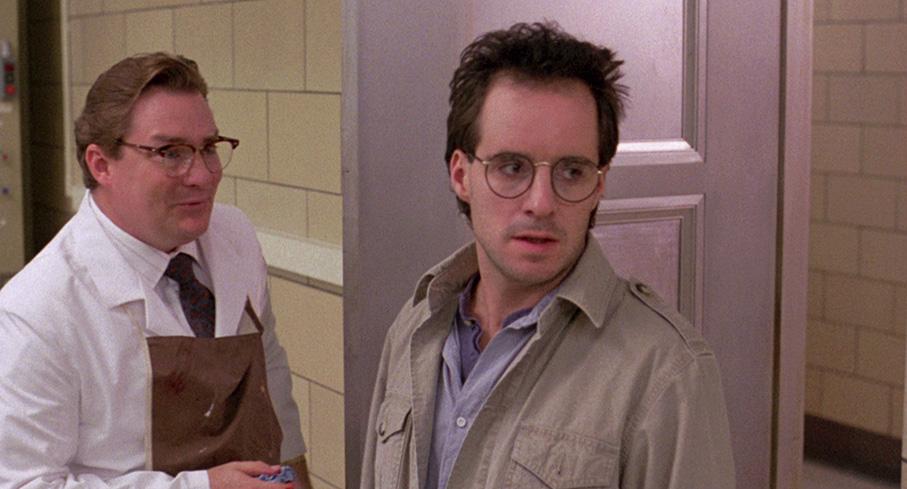
There's a choice between LPCM 2.0 mono and DTS-HD Master Audio 5.1 surround. Both are clear, but with the dialogue sitting centrally on the DTS track and spread across the front speakers on the mono. There's a more noticeable treble bias on the mono track, while the bass response on the DTS track is far more robust, particularly during the thunderstorm climax, though there's not much happening at the rear in any scene.
Optional English subtitles for the deaf and hearing impaired have been provided.
Travis Crawford Commentary
Film journalist, historian and programmer Travis Crawford follows up his previous commentaries on the three films in Arrow's George Romero: Between Night and Dawn box set, and the results are every bit as informative, with the added bonus that the audio quality has been improved since the tracks on the earlier release. I'm not sure I needed to hear just about every film that the key cast members appeared in exhaustively listed, especially as I can look this up in seconds on IMDb, and I'm guessing a few eyebrows will be raised at Crawford's views on what he regards as the best films of certain filmmakers (I certainly did), but there's so much else here of real interest that I'm not going to gripe. I was particularly intrigued (and frankly impressed) to learn that actor Jason Beghe was a former poster-boy for Scientology, but later left the movement and became one of its most vocal opponents.
George Romero Commentary
Hosted by the colourfully named Stuart Feedback Andrews of Cinephobia Radio and sourced from an earlier disc release, this commentary by director Romero is an invaluable and hugely enjoyable companion to the film. Topics covered include: changes he made to the novel; casting John Pankow after seeing him in To Live and Die in L.A.; the Helping Hands monkey training programme; temp tracking the film with Henry Mancini music; working with Boo, the monkey that played Ella after a false start with other animals; his working relationship with regular editor Pascale Buba; losing the rights to use Ella Fitzgerald songs in the film; his cameo appearance in The Silence of the Lambs; and much more. He also addresses the issue of the film's altered ending and the part of it that the test audience took issue with – he reveals that he and the studio were in complete agreement about having it play out this way (he made a conscious decision to alter the ending of the book), but in retrospect thinks they were misguided to do so. With you on that.
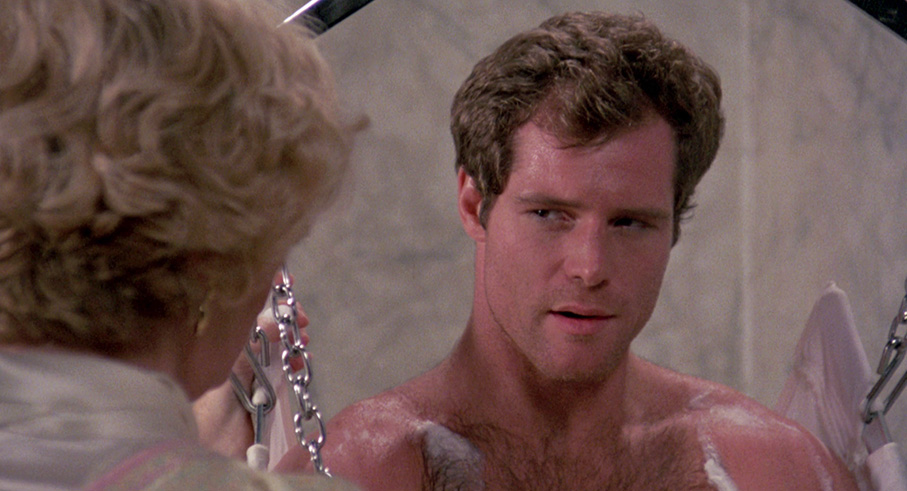
An Experiment in Fear: The Making of Monkey Shines (49:32)
A Scream Factory and Red Shirt co-production licenced from a previous American disc release, this comprehensive overview of the making of Monkey Shines is built around interviews with writer-director George Romero, executive producer Peter Grunwald, actors Kate McNeil. Jason Beghe and John Pankow, editor Pasquale Buba, and special makeup effects artists Tom Savini, Greg Nicotero and Everett Burrell. Inevitably, there's a good deal of crossover with the other extras on this disc (almost every story here also appears elsewhere), but this is still an entertaining inclusion and a good place to get started with the special features after you've finished watching the film. I particularly enjoyed Romero's summing-up of the problems of having a monkey in a key role: "The one thing about them is they're capable of saying 'Fuck You. No, I'm not going to do that right now. Get out of here!'"
Deleted Scenes (4:07)
Three short extensions to existing scenes that don't add anything significant to the characters or story but are of interest nonetheless, plus one that reaffirms something that Allan's mother refuses to acknowledge – I can't elaborate on that without delivering a spoiler.
Alternate Ending (5:09)
The ending as Romero originally intended, without the studio-enforced shock gag but still with the element I have issue with, and a final freeze-frame that risks tipping the film over into comical camp.
Vintage 'Making of…' (5:21)
A mix of insubstantial interviews with cast and crew members and on-set footage, laced with a comically announcement-like voice-over.
Behind-the-Scenes Footage (13:16)
Footage shot by Savini and his team of Boo and her owner, plus what looks like the monkey that Boo replaced (it's not that I recognise her, just that she is scratching herself constantly, which is how she was described by Romero in the making-of documentary) and tests done by the effects team with animatronic and puppet monkeys.
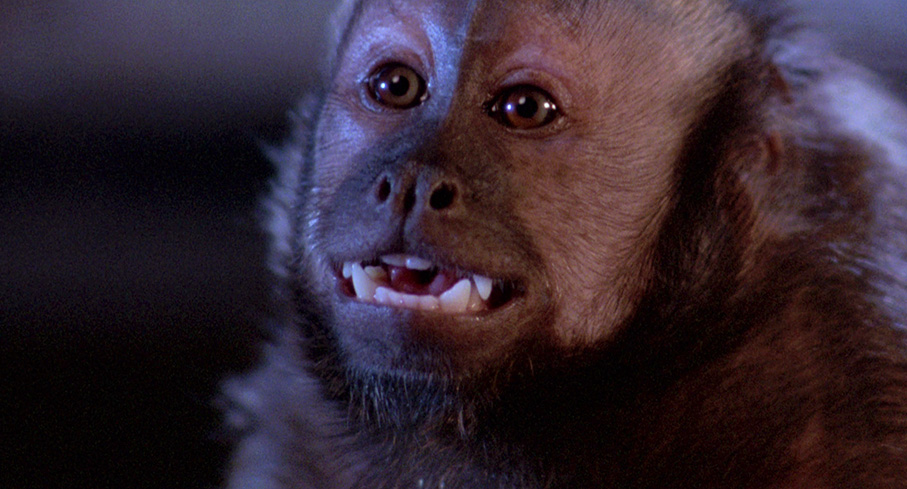
Archival Interviews and News Feature (5:44)
Footage from the archive making-of featurette in its unedited form.
Trailers & TV Spots
Theatrical Trailer #1 (1:55) has a couple of spoilers, but is very well-edited and a decent sell. Theatrical Trailer #2 (1:29) is built around the poem used on the poster, one that equate being in a wheelchair with a prison sentence. I'm guessing this is the trailer that fired up the disabled group hat protested the film's premiere. The TV Spot (0:33) is a shorter version of theatrical trailer #2.
Also included in the first print run only is a Limited Edition Collector's Booklet featuring a new essay by Craig Ian Mann, highlights from the film's production notes and rare archival material, but this was not available for review.
A strong and involving horror-thriller whose smart direction, ace editing and fine performances really sell a concept that should come across as a little silly but never does, while the presentation of Ella as a convincingly lethal threat allows Romero to deliver a belter of a climax. A decent transfer is backed by a very fine collection of special features, which make this a must-have for Romero devotees and discerning genre fans. Warmly recommended.
|